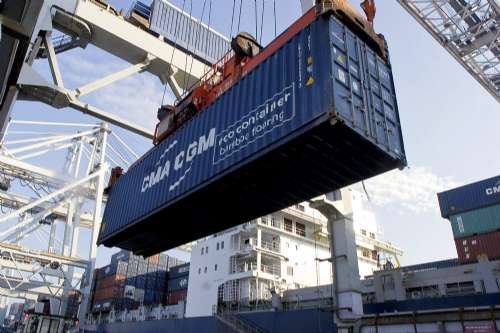
The pic above: The liner industry has restructured its fleet operations in the past two years, and the average environmental efficiency per container has significantly improved.
According to Ta Kung Pao’s news reported on 21 December, MDS Transmodal, the British freight market consulting company, recently published a research report in London which pointed out that although the global carbon emissions of container ships may still be increasing, the average carbon dioxide emissions per TEU this year is 1.41 tons, or 278 grams per TEU nautical mile, which is more than 25% less than in 2006. Under the double factors of the financial tsunami and the slowdown of large container ships, the liner industry is trying to reduce the environmental pollution of ships. Reports from the Baltic Shipping Council (BIMCO) also pointed out that the slowdown of liner ships and the order of large ships is becoming a trend, the new generation of container ships will be equipped with lower speed engines, and the cargo will be more concentrated in a few hub ports, which will help promote the environmental development of the industry.
International shipping giant A.P. Moller -- Maersk Line Group, on behalf of the global transportation industry, said earlier at the United Nations Climate Change conference in Mexico that the representatives of participating countries should promote the "green label" showing the carbon emissions of logistics supply chains on consumer packaging, showing the industry's intention to gradually promote environmentally friendly operations and show the results to the outside world as soon as possible.
After the impact of the financial tsunami, the global container shipping volume is growing again. The MDS report points out that the global container shipping volume is expected to reach 127 million TEUs this year, involving 644 billion TEUs in nautical miles. Compared to the 102 million TEUs in 2006 and 515 billion TEUs in nautical miles, both have increased by 24.5% and 25%, respectively. The overall carbon dioxide emissions of the liner industry are still growing.
However, due to different transportation volume bases, it is difficult to accurately evaluate the effectiveness of the industry in promoting environmental protection measures by calculating the total amount of carbon emissions within the industry in a general manner. MDS, in collaboration with Box Trade Intelligence, another UK liner market consulting company, has launched a calculation method for carbon emissions per TEU and per TEU in the sea, hoping to further reflect the true impact of environmental measures on each TEU during transportation.
The report results indicate that the average carbon emissions per TEU of the liner industry have dropped to 1.41 tons this year, a decrease of 25.8% from 1.9 tons in 2006. The discharge per TEU in the sea is 278 grams, a decrease of 25.3% from 372 grams in 2006. MDS Executive Director Galanzi stated that the main reasons for the improvement in the two indicators are the slowdown of liner services and the entry of more large vessels into the market.
Using low-speed ships to significantly reduce fuel consumption
During the global financial tsunami that swept through the world last year, several shipping companies implemented a slowdown operation in response to the contradiction between insufficient domestic cargo volume and overcapacity. The liner company will slow down the container ship by half to one-third and transfer additional ships to maintain the schedule as much as possible, in order to digest excess ships and reduce fuel consumption. In addition, the delivery of large vessels by more shipping companies has significantly reduced the fuel consumption cost per TEU, which helps to suppress the growth of carbon emissions.
The MDS report specifically points out that from 2006 to this year, the cumulative demand for container shipping on the Asia Europe route has increased by about 24%, but carbon emissions have not skyrocketed with it. Instead, they have decreased by 24%. This is because the Asia Europe route is a key route for shipping companies to implement deceleration policies for large vessels, so the industry can make great progress.
BIMCO stated in another market report that, like other types of ships, container ship owners and operators are facing changes in the market environment and external pressures from environmental considerations, and pointed out that the industry should consider the current low fuel consumption operating mode as a long-term trend. The report states, "For environmental reasons, reducing speed on liner ships should become a routine, allowing the new generation of container ships to be equipped with lower speed engines and operate at low speeds."
24% reduction in carbon emissions along the Asia Europe line
The conference also stated that more major shipping companies are accepting new container ships with a capacity of over 10000 TEUs, and some industry leaders plan to purchase container ships with a capacity of over 16000 TEUs for the first time in the short term. Although large ships may reduce the number of voyages for shipping companies, under economies of scale, the operating costs per TEU will be reduced, and carbon emissions will also be reduced.
The report points out that reducing the number of voyages is not a major issue, as there is a trend that major liner routes are more concentrated at hub ports, and then goods will be dispersed to nearby areas by small feeder container ships, which will become an existing operating model in the industry. The association also stated that ports and docks in various regions currently have greater pressure upgrade capabilities to meet the operational needs of large ships.

 CN
CN

![[list:title]](/static/upload/image/20240523/1716425568146093.jpg)
![[list:title]](/static/upload/image/20240523/1716425466730827.png)
![[list:title]](/static/upload/image/20240523/1716425496175720.png)
![[list:title]](/static/upload/image/20240523/1716425522476485.jpg)
![[list:title]](/static/upload/image/20240523/1716427565435344.jpg)
![[list:title]](/static/upload/image/20240306/1709710927521266.jpg)
![[list:title]](/static/upload/image/20240306/1709710907370023.jpg)
![[list:title]](/static/upload/image/20240306/1709710766128139.jpg)
![[list:title]](/static/upload/image/20240306/1709710749735821.jpg)
![[list:title]](/static/upload/image/20240306/1709710719323252.png)
